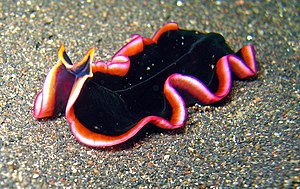Pseudobiceros gloriosus
| Pseudobiceros gloriosus | ||||||||||||
|---|---|---|---|---|---|---|---|---|---|---|---|---|

Pseudobiceros gloriosus |
||||||||||||
| Systematics | ||||||||||||
|
||||||||||||
| Scientific name | ||||||||||||
| Pseudobiceros gloriosus | ||||||||||||
| ( Newman & Cannon , 1994) |

Pseudobiceros gloriosus is a flatworm from the order of the Polycladida . The name is derived from the Latin word gloriosus and refers to the colorful appearance of the animals.
features
Like many members of its genus, Pseudobiceros gloriosus has a mainly monochrome epidermis , which is lined with bands of different colors. However, unlike most other species, it has three bands instead of two. Characteristic for the species is also the expression of the colors: The main color of the back epidermis is velvety black, followed by a wide orange band, followed by a middle narrow pink band and an outer extremely narrow dark castle red band. The largest individuals have a thin pink median line that begins at the cerebral eye spot and extends over about three quarters of the body length. The two pseudotentacles have orange and burgundy red bands. The abdominal epidermis is dark burgundy red.
The species is relatively large. Adult individuals reach 70 × 25 millimeters to 90 × 50 millimeters. Young animals are 28 × 12 millimeters in size.
The pseudotentacles of Pseudobiceros gloriosus are square and slightly curled. The cerebral eye spot consists of around 200 ocelles .
Flatworms are hermaphrodites . Pseudobiceros gloriosus has two male and one female sex systems, each of which is located in a flat antrum . The two male genital openings are very close together. An oval large seminal vesicle, a long twisted injection channel, an oval prostate and a long stylet each form one of the two male sex systems. The spermatic duct is branched.
Occurrence
Pseudobiceros gloriosus is common on Heron Island , a coral cay at the southern end of the Great Barrier Reef . Occasionally they can be found on Bagabag . Finds in the Fiji Islands have also been reported. Potential habitats are under ledges of reef slopes.
literature
- Leslie J. Newman, Lester Robert Glen Cannon: Pseudoceros and Pseudobiceros (Platyhelminthes, Polycladida, Pseudocerotidae) from eastern Australia and Papua New Guinea. (PDF; 12.2 MB) In: Memoirs of The Queensland Museum 37, 1994, pp. 246–248.
Web links
- Information and pictures (English)